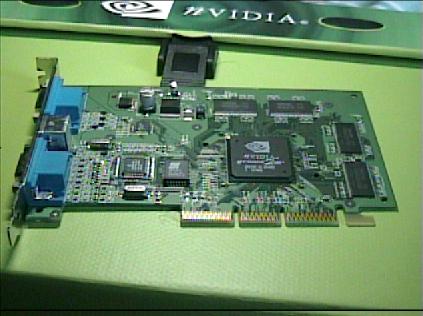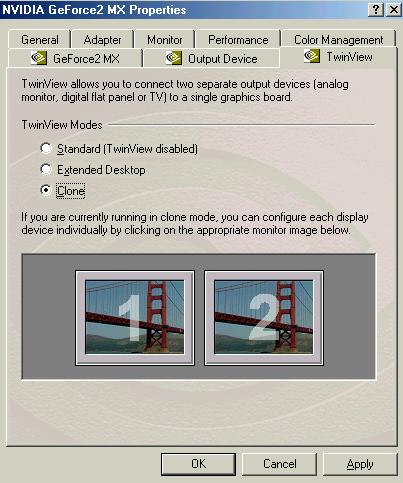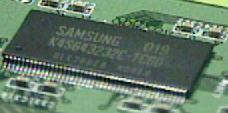Nvidia GeForce2 MX

What I noticed right away was how compact the card was. It’s about 5′ in length and 3.5′ across. (it doesn’t get any smaller does it!). As the picture shows our reference MX board is running totally stripped! Look mom no fan! No heat sink!
NVIDIA was able to go without the heatsink and fan because the MX uses far less power than it’s big brother the GTS.There are 8 holes around the chip, which allows the use of a wide variety of heatsinks or fans for extra cooling. But for our overclocking experiment I didn’t use these holes and just used a piece of Velcro to attach the fan.
Twin View
The reference board we received features Nvidia’s answer to Matrox’s DUALHEAD; TWIN VIEW

TwinView Clone Mode
TwinView is basically a duplicate version of Matrox’s DualHead feature, which proved to be the strongest selling point of the DualHead G400’s since these cards were never known to give the best 3D performance. Graphic artists and programmers who find the twin monitors incredibly tantalizing love the DualHead feature. So Nvidia has learnt what they need to do, and introduced the TwinView feature with the MX chip.
TwinView offers the standard dual display modes: Win98 multimonitor support, application exclusive, clone, zoom, and virtual desktop. The board we received has two D-sub analog outputs for running two CRT monitors. A separate external RAMDAC chip on the board supports this feature.

The MX can support several different dual display combinations:
Two digital flat panels
Two RGB monitors (with second RAMDAC)
Two analog flat panels
One digital flat panel and one analog flat panel
One digital flat panel and one RGB monitor
One digital flat panel and one TV
One RGB monitor and one TV
One RGB monitor and one analog flat panel (with second RAMDAC)
One analog flat panel and one TV
It has to be noted that not every MX card will be able to offer all the possible dual display combinations. The amount of combinations that’ll be supported depends on the type and number of video outputs the board manufacturer puts on the card.
The Memory
The board came with 4, 8MB(32MB) chips of 166MHz SAMSUNG SDRAM. (Which caps memory bandwidth at 2.7 GB/s). But some manufacturers have boards with faster memory, for example the Hercules 3D Prophet II GeForce2 MX we reviewed a while back had memory chips rated at 5.5ns (In order to facilitate the 183MHz clock). The chip can support 8-64MB, but we mostly see 16MB and 32MB configurations.

OverClocking:
The card is clocked at 175 MHz core and 166 MHz memory. Since the GeForce2 MX already runs pretty cool (don’t forget there’s no heatsink or fan) and uses very little power I was looking forward to a wonderful experience indeed.
Well this board doesn’t have any overclocking sliders like the Hercules 3D Prophet II GeForce2 MX. I used the CoolBits registry entry to gain access to the overclocking options in Nvidia’s reference driver set.
Exclusive of any on-chip cooling, I was able to clock the card up from 175/166 to a much more contented 205/200. Which even barely tops the GeForce2 GTS in raw clock speed. But then after a while things started to heat up quite a bit and a fan fixed directly on the chip had to be used for more cooling. Overall, large performance increases in frame rates were only visible at the higher resolutions.
Test Setup:
We tested the card on two systems, a low end Celeron 600 and a mid range P III 700. The benchmarks will show what to expect from this card. So go on reading
| CPU | Intel Celeron 600, Pentium III 700 |
| Motherboard | Pentium III 550E Micro-Star International BXMaster Motherboard |
| Video Cards | Elsa Gladiac Geforce 2 GTS(200/333)
Hercules 3D Prophet II MX(175/183) MSI Starforce GF 256(120/183) ELSA Erazor X2 GF256 DDR(120/333) (Nvidia Detonator 3 Drivers) |
| Memory | 128MB of Mushkin PC133 RAM |
| Harddrive | Diamond Maxtor 80GB |
| OS | Windows 98SE |